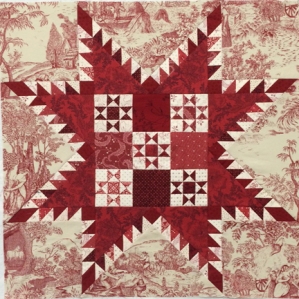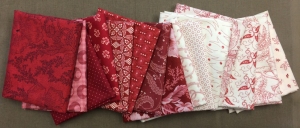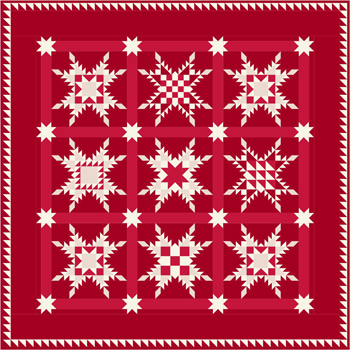It happens regularly: a quilter sees one of my patterns and wants to make the quilt in a different size. She writes to me asking that I figure the yardage for her to make a quilt that measures x” by x”. This is what I generally send as a reply.
#1. Most quilt fabric is 42″ to 44″ wide. For figuring purposes, you can count on 40″ usable width after shrinkage and cutting off selvages.
#2. Take each shape of each color in your quilt design and determine how many patches are needed.
Example: Each block needs four 2-1/2″ red squares.
There are 20 blocks. 4 x 20 = 80.
Divide the width of the fabric, 40″, by the cut size of the square, 2.5″, to get the number of squares that can be cut from one strip 2.5″ wide.
40″/2.5 = 16 squares per row.
Divide the total number of squares needed by the number that can be cut from one strip 2.5″ wide, to get the number of rows of squares needed.
80/16 = 5 rows.
Multiply the number of rows by the size of the square to get the number of inches of fabric needed.
5 x 2.5″ = 12.5″
( If you need other shapes from the same fabric, go through the same process and add the inches together.)
To allow for shrinkage, multiply the number of running inches needed by 106%.
12.5″ x 106% = 13.25″
This is almost 3/8 yard (3/8 yard = 13.5″). So 3/8 yard should be enough fabric for eighty 2-1/2″ squares. If you don’t mind having a little extra, buy ½ yard.
#3. Repeat the above for each shape and fabric in your quilt plan. I know it’s a pain, but if you feel the need to buy just the right amount, then all that figuring is what is needed.
This is also why I do not figure yardage for individuals’ quilts — it just takes a long time and there are a lot of variables … and you’re better off knowing how to do it yourself.
(OR you can make scrap quilts and just collect a whole bunch of reds and when you run out of one print, start cutting from another.)
It is, however useful to get a ball park amount of yardage for a quilt. One method I use is to take the amount of yardage needed for the backing of the quilt and multiply it by 1-1/2 to get an approximate amount for the quilt top. So if you need 6 yards for the backing, you’d need somewhere in the neighborhood of 9 yards (plus) for the top. This is good information in case you go through all the calculating and come up with a total of, say, 25 yards. 25 yards is nowhere near the 9 yard ballpark figure, so you treat that as a clue that something went wrong with your figuring. If your calculations gave you a total needed of 10-1/2 yards, I would consider that in the “ball park” and have confidence to buy that amount.
And then there’s the old saying: “If a fabric is worth buying, it’s worth having.” So buy a little more that you need to build up your stash.
Inches to Yards Chart
This will help you convert your calculations to yardage amounts.
4-1/2” = 1/8 yard
9” = ¼ yard
13-1/2” = 3/8 yard
18” = ½ yard
22-1/2” = 5/8 yard
27” = ¾ yard
31-1/2” = 7/8 yard
36” = 1 yard
40-1/2” = 1-1/8” yards
45” = 1-1/4 yards
49-1/2” = 1-3/8 yards
54” = 1-1/2 yards
58-1/2” = 1-5/8 yards
63” = 1-3/4 yards
67-1/2” = 1-7/8 yards
72” = 2 yards
















 I just heard from Clothworks that my new fabric line, Raspberry & Cream, is now being shipped to stores!! I’ll be getting my bolts at Feathered Star Productions
I just heard from Clothworks that my new fabric line, Raspberry & Cream, is now being shipped to stores!! I’ll be getting my bolts at Feathered Star Productions





